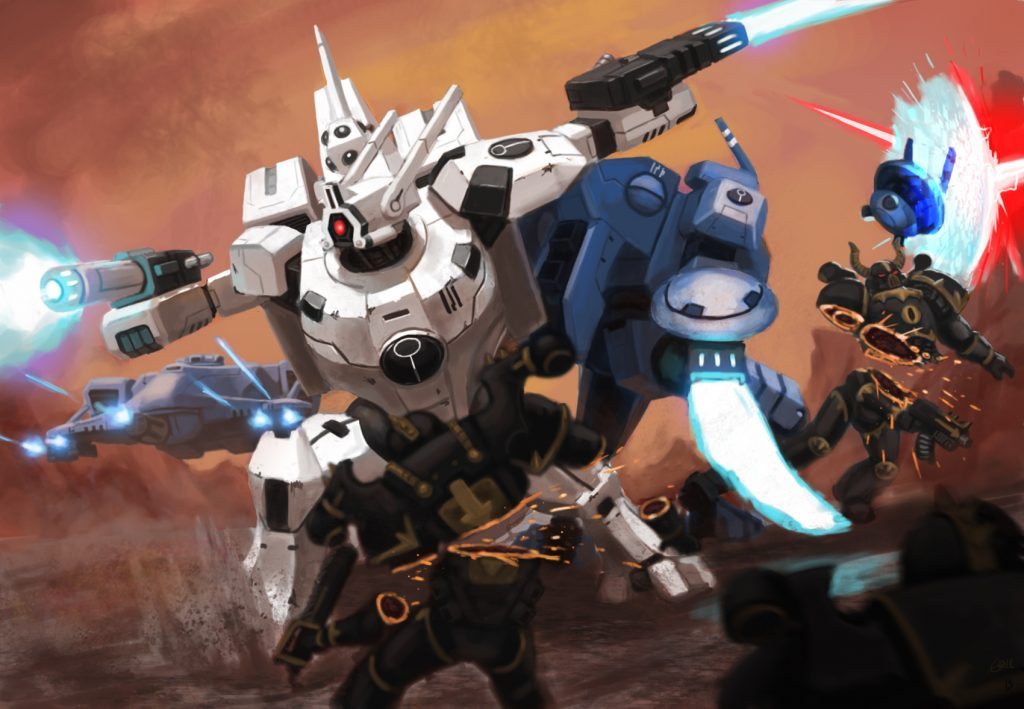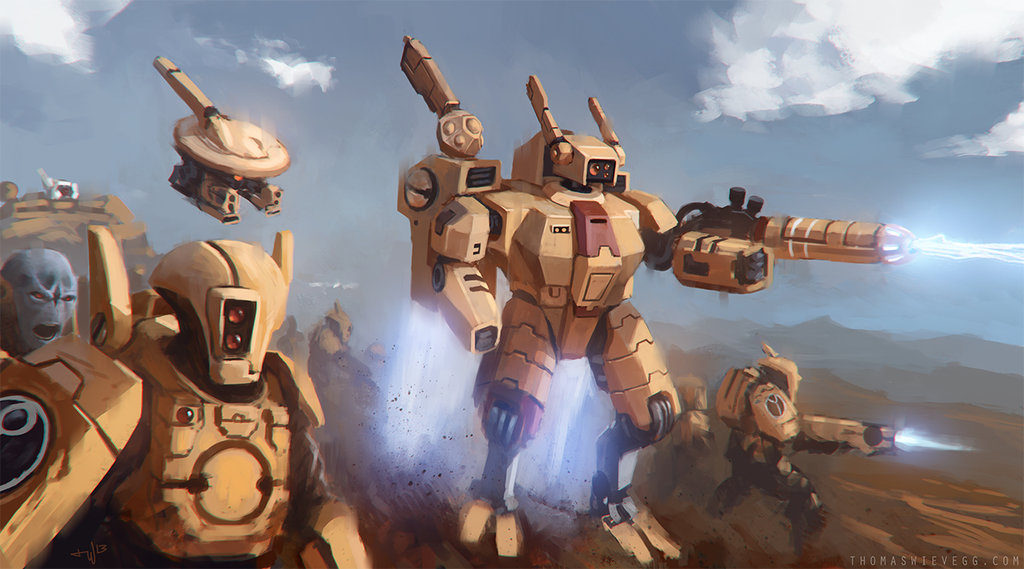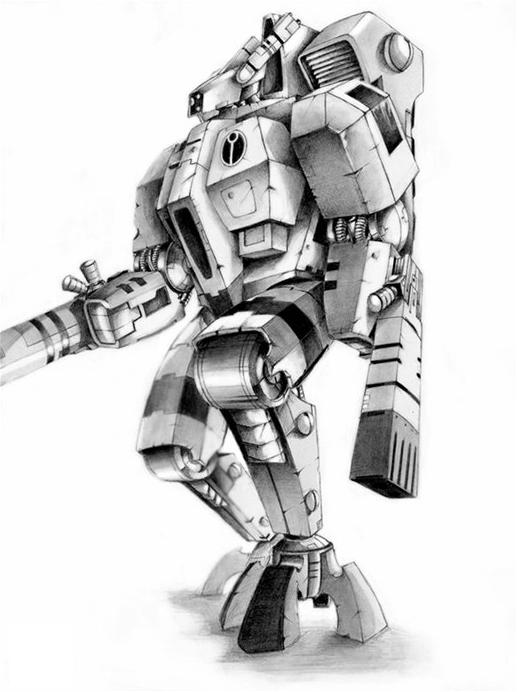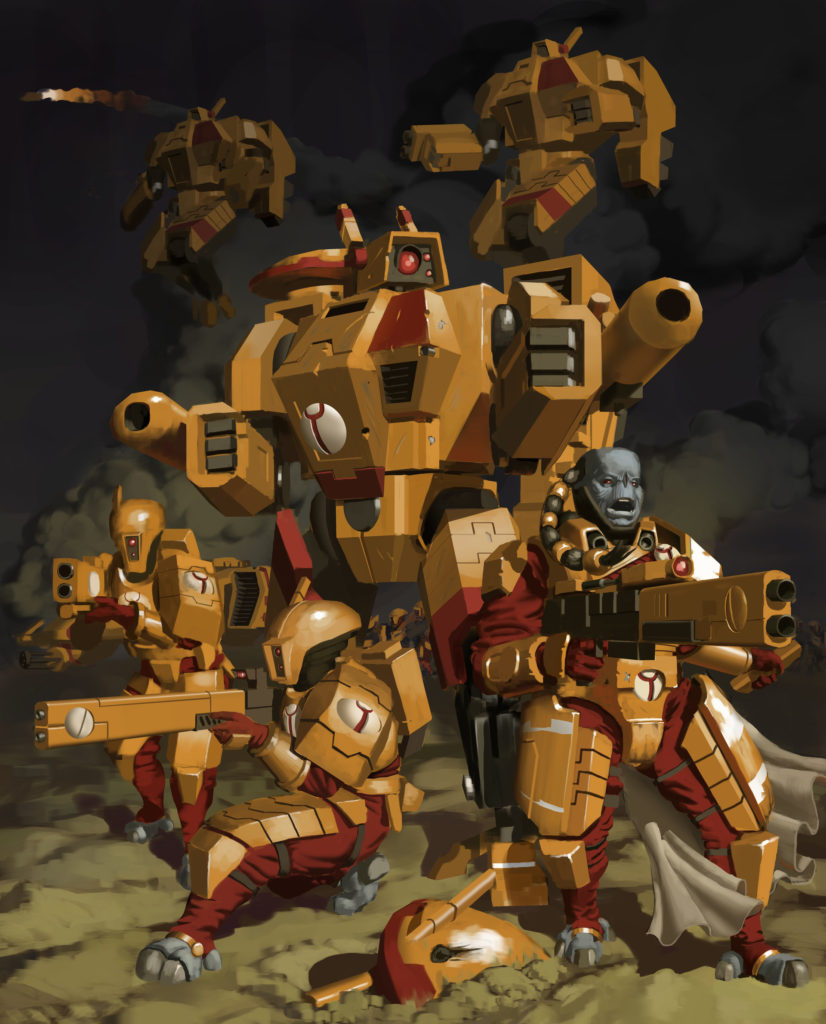When your personal protector is fifteen feet tall and made of advanced nanocrystalline alloys shaped around a nuclear core, perhaps you are being a bit overcautious with personal protection. Click to read on, or check out the Tactics Corner for more reviews and strategies.
Overview
As a member of the Fire Caste rises up through the ranks, it is only natural that many of their compatriots will likewise rise with them- members of a fire team often graduate together, enter combat together, and receive promotions together. As an individual earns their honors and is allowed to pilot a battlesuit, their team-mates often join them in this role, eventually if not immediately. Such groups inevitably undergo the Talis’sera, the ritual of bonding that unites members of a team together in a shared purpose and affirms their loyalty to each other. Even as some members climb the upper echelons of the Fire Caste command structure, their bondmates do not abandon them- the Tau Empire, after all, recognizes the value of personal loyalty in service to the Greater Good and encourages it where appropriate. Should an talented individual rise to the rank of Commander, their bond-mates are often assigned as aides-de-camp or bodyguards, the better to support their leader without impunging on their position.
On the table, Crisis Bodyguards have a pretty beefy statline that is largely identical to their counterparts. Strength and toughness five are solid, especially with three wounds and 3+ armor to back them up. Ballistic skill 4+ is standard for Tau, as is the lackluster 3+ weapon skill. Three attacks per model, though is surprisingly high- though it’s hard to make use of due to the shoddy weapon skill. Squads can be anywhere between three and nine models in size; depending on equipment the price is generally somewhere between 40 and 80 points per model, though the basic chassis cost is 30pts (or 3pts more than a standard Crisis.)
Wargear and Special Rules
Crisis Bodyguards come with an array of special rules, although most of them are common to the faction as a whole or to Crisis Suits of all varieties. For the Greater Good, of course, allows them to support nearby units with Overwatch; Manta Strike allows them to deploy into reserve and arrive on a later turn; Bonding Knife Ritual lets them pass morale automatically on a roll of 6. While it’s not to say these aren’t useful abilities, they aren’t particularly exciting due to being common to many units.
Sworn Protectors is the Bodyguards’ unique rule, which is similar to other rules in various factions in the game. When a character from the same sept loses a wound, you roll a d6 and on a 2+ the character suffers no damage, with the Bodyguard instead taking a mortal wound. Note that this roll is not optional, so do be careful about where you position your Bodyguards if you expect the enemy to be able to focus on your character, as you wouldn’t want to lose both them and the Crisis unit at the same time.
Like standard Crisis Suits, Crisis Bodyguards come equipped with a single Burst Cannon, but that can be swapped out for up to three weapons and/or Support Systems in any combination, which should always be done. They also have the option of taking up to two drones per squad member, in the same fashion as Crisis.
Uses
So, Crisis Bodyguards largely function like slight upgrades to a regular Crisis Suit unit, which I have discussed in detail already- I would suggest reading the linked article for a starting point, because pretty much everything that was said there applies to Bodyguards as well. However, you’re paying a couple of points as a premium to add a small handful of changes to a unit, so I think if you’re looking to make use of Bodyguards, we have to focus on those changes; otherwise, why not just take the regular Crisis instead?
The extra attack is something, although it isn’t very much without a better ability to hit things in combat or even a melee weapon that might be of some use. Though it technically differentiates them, there is no really useful way to take advantage of it- Tau simply don’t have the tools. Instead, let’s focus on the other thing- the ability to protect characters. Tau are an army that is often reliant on auras from their various HQs; while this might not be true to the same degree that, say Genestealer Cults or Orks are, Tau still have a lot of powerful characters that the enemy might want to get rid of, many of which are fairly fragile. Ethereals in particular are very vulnerable to getting sniped by the enemy with their low toughness and weak armor save, and with the wide-ranging benefits they can provide to an army it is extra-important to keep them alive (both narratively and mechanically.) Cadre Fireblades are also fairly vulnerable, although somewhat less so, and even Commanders can easily be brought down in a hail of mortal wounds should the right rolls happen.
Now, other options do exist to protect these characters- simple movement can do the trick in many cases by denying the enemy line of sight to them, as their auras can penetrate walls and other terrain. However, this isn’t always convenient, so we can’t consider it an absolute solution. Savior Protocols, available on all drones, can stop most types of damage (though not targeted spells which deal wounds, a tactic several armies use to get rid of things); however, Savior Protocols is typically resolved for bigger weapons that are attempting to down your heavy-hitting units such as Riptides, and so using them to protect a character is sometimes not optimal (especially if it’s just Boltguns or the like being aimed at them.) Crisis Bodyguards allow you to fill this intermediate gap. Although somewhat less efficient than drones at the job, they have the advantage of being able to perform other roles in addition to simply intercepting wounds- so in matchups where you don’t need that ability, they can go off and do their own thing.
However, the comparatively expensive price per wound (even at the lower end of the spectrum, such as a triple-Flamer setup) means that this plan, while not completely awful, is not terribly exciting, either. The 9pt premium you pay over a basic Crisis Suit unit isn’t backbreaking, but in most cases you won’t see anything as a result of it, so it’s kinda thrown down the garbage from a competitive perspective and is an easy place to cut.
Countering
Crisis Bodyguards are pretty much identical to regular Crisis, so I won’t go into all of that. However, if you’re considering how to get around their Sworn Protector ability, remember that wounds spill over from the character and that it is not optional- if you can radically overkill the character, it’s possible to get two birds with one stone. This will most commonly happen in melee combat or similar, such as getting a unit with a Thunder Hammer into close combat with the character and dealing 12-18 wounds to them. The Bodyguards themselves can, of course, be targeted as well, though especially with fragile characters (such as an Ethereal) this is actually less efficient than aiming at them, as their higher stats and better armor make it harder to push a wound through.
Final Thoughts
The Crisis Bodyguard, although not a bad unit, has very little reason to exist within the context of a Tau army- there’s nothing truly unique that they do and other units cover pretty much all of their bases pretty easily. Unfortunately, with the changes in role for 8E, this sort of thing is not uncommon- though thankfully the Tau codex doesn’t suffer from it nearly so much as many of the Imperial ones do, as they have buckets of redundant units that serve no real purpose. Hopefully the next time around the design team will pivot on Bodyguards and perhaps give them a new role within the book, or some more unique options or abilities.
As always, remember you can get your wargaming supplies at great discounts every day from the Frontline Gaming store, whether you’re looking to expand an existing army or start a new one.





I admit that I am clutching at straws here but if you really absolutely need to keep a Character alive then the combination of Saviour Protocols and Sworn Protectors will give you belt and braces protection. Take Saviour Protocols against big multi-wound hits as usual while aiming to take most of the small-arms hits that beat the Character’s save on the bodyguards. When you fail a Saviour Protocols roll you still have the safety net of Sworn Protectors. Also note that unlike Saviour Protocols this does protect against things which do not count as attacks, which includes psychic powers and stratagems, so there is also that silver lining.
Unlike drones your Crisis Bodyguards do benefit from Sense of Stone so might have a 6+++ to give them a tiny bit more durability. However the core issue remains that crisis bodyguards are too expensive to be throwing their wounds away lightly and a single big hit from a titan-class weapon getting through can wipe a whole unit of them because of the conversion to mortal wounds.
Is it worth the 9 pts to have that ability in your list plus the Shas’vre statline on all your crisis suits? Probably not but as you say it is not awful, just rather lacking in a clear payback for those 9 points.
If crisis teams were amazing this unit would give you the option to slide another 3 teams past the rule of 3 at a small points premium. As crisis teams are far from amazing it seems unlikely that anyone will want to bother.
I dunno. Given the kinds of things that are likely to be shooting at a T’au Leader, a bodyguard fifteen feet tall and made of advanced nanocrystalline alloys shaped around a nuclear core doesn’t seem too unreasonable. To me the issue is more that they seem to be selecting the bodyguards on the basis of their ability to punch people, when this has no relevance to any aspect of their job
Can you use these guys to protect Longstrike and keep him alive? I thought that was one of their (only) uses. Then you can use drones to protect the bodyguards themselves from attack and force the enemy to burn though a bunch of bodyguards before damaging Longstrike.
So, wound conga where Longstrike gets wounded by something (probably a Castellan), the bodyguards jump in front of it, then the drones jump in front of them? I’m not sure that’s legal, but the mental image is hilarious.
@NinetyNineNo you misinterpreted what he said. The Crisis suits are there to take wounds for Longstrike if he is directly targeted. The drones are there to take wounds for the Crisis Bodyguard if THEY are directly targeted.
You couldn’t use Savior Protocols for the Bodyguards if they’re using their special ability to intercept wounds for Longstrike.
Though at least this provides some protection for longstrike given he can’t use shield drones.
Given the option to heal back up battlesuits, the bodyguard might make longstrike and hammerheads viable as there’s a chance he could make it past the first turn or two of shooting.
I don’t think it does, unfortunately; with only three wounds each they die pretty easily to a lot of things (like a Castellan, for example) and the upside to using the Hammerheads isn’t nearly as high as it used to be now that options like Broadsides are around.
Regarding Sworn Protectors, I’m not sure it’s as clear cut as you say.
RAW it’s mandatory to roll, but the rule says that (on a success) they “can” intercept the hit. So (in my view) it isn’t actually mandatory for the bodyguard to take the mortal wound.
It does seem odd that we would have to roll even if we wouldn’t use it if we pass, but there’s other cases where we have to make pointless rolls – rolling for damage agaimst single wound models, rolling morale when there is no possibility of losing a model (or keeping the unit)…
There’s an argument to be made there, I suppose; I haven’t seen an actual ruling on the subject so I can’t say with absolute certainty, but that was my reading of the rule at least.
Psychic powers are not considered “enemy attacks”? WTF?
It has a FAQ and everything – smite is not an attack. Or at least not for the purposes of Saviour Protocols. Its not as silly as using flamers for anti-aircraft fire so I just shrug my shoulders and carry on having fun.